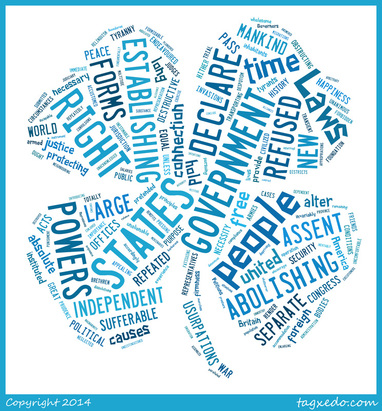...to secure these rights, Governments are instituted among Men, deriving their just powers from the consent of the governed, --That whenever any Form of Government becomes destructive of these ends, it is the Right of the People to alter or to abolish it, and to institute new Government, laying its foundation on such principles and organizing its powers in such form, as to them shall seem most likely to effect their Safety and Happiness. Prudence, indeed, will dictate that Governments long established should not be changed for light and transient causes; and accordingly all experience hath shewn, that mankind are more disposed to suffer, while evils are sufferable, than to right themselves by abolishing the forms to which they are accustomed.
But what if I told you that there was a way to show students how to get at a main idea in a difficult text like the Declaration, and they only had to, say, understand maybe 1/8 of the words?
Here's how we used our patterning strategy to blow these kids' minds and help them understand a really tough document:
We made a word cloud.
No, seriously.
First, we had them try to read the text of the Declaration. This lasted about 90 seconds before their eyes started to roll.
Then, I proposed to them what I just proposed to all of you: What if I told you that you could understand the main idea of this text without having to read it? What if I told you you didn't actually have to know Every. Single. Massive. Word. to be able to comprehend one of the most important texts in our country's history? Ears perked.
I told them to look at that clover image (made with Tagxedo). Obviously, the point of a word cloud is that it arranges the most common words from a passage into a shape, and the more frequently the word is used in the text, the larger it appears in the image.
So, what are the biggest, and thus most commonly used, words in that image above? Your list would look something like this:
- states
- government
- powers
- abolishing
- people
- refused
- establishing
- right(s)
- laws
- time
- declare
- assent
- new
Now, most of the readers of this blog know all of those words. And high school juniors know most of them, but I did have them quickly define each (via Google and then in their own words).
You can probably see where this is going now, right? Even if you've never read the Declaration of Independence, you can tell a couple things immediately from this list. First, it's about some kind of government/governance, and it's probably about getting rid of an old one and creating a new one (because of the repeated use of "new," "abolishing," and "establishing.") And second, it seems that the writer is upset/angry; you can figure this out from the negative undertones of "abolishing," "assent," "refused," and "usurpations."
If you put those two ideas together, as it turns out, you end up with a pretty good summary of the content of the Declaration of Independence. And you didn't have to even read the thing. At all.
Obviously, the ultimate goal is that students would read these texts fully and understand them completely. However, this strategy can give them a leg up on writing argumentation paragraphs, even if they have no idea what the text is saying. Also, you end up with a cool backdoor effect: if kids can pattern like this and get a global sense of the text, then it makes it far easier to understand when they actually have to go back and read the thing. I mean, if I already front-loaded that what I'm reading is about government, probably establishing a new one, and that some people in the text are kinda angry, then I'm going to be a lot more successful in understanding/writing about that text.
I'm sure you all can think of better ways to use this strategy, or ways to improve upon it. Please share your ideas! As always, take, steal, use, improve, and cite. Look forward to seeing how this evolves.


 RSS Feed
RSS Feed
